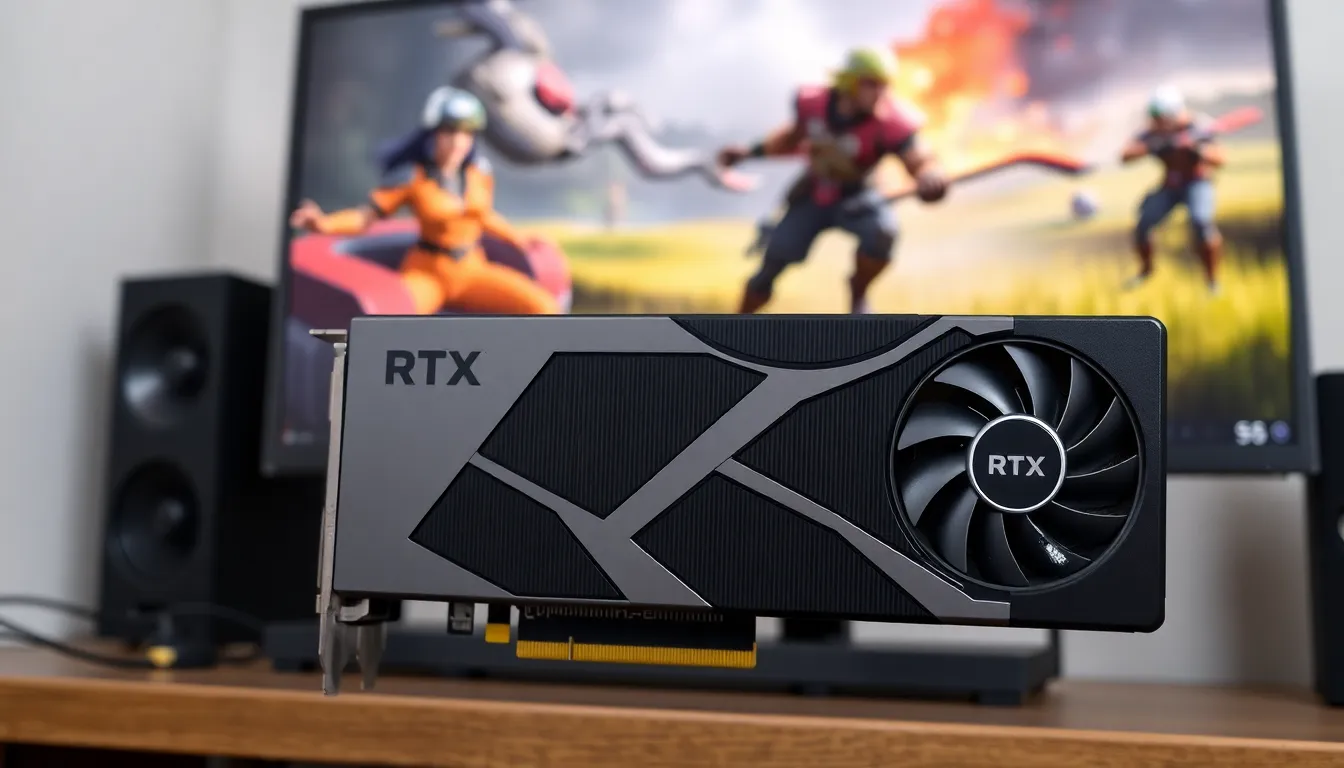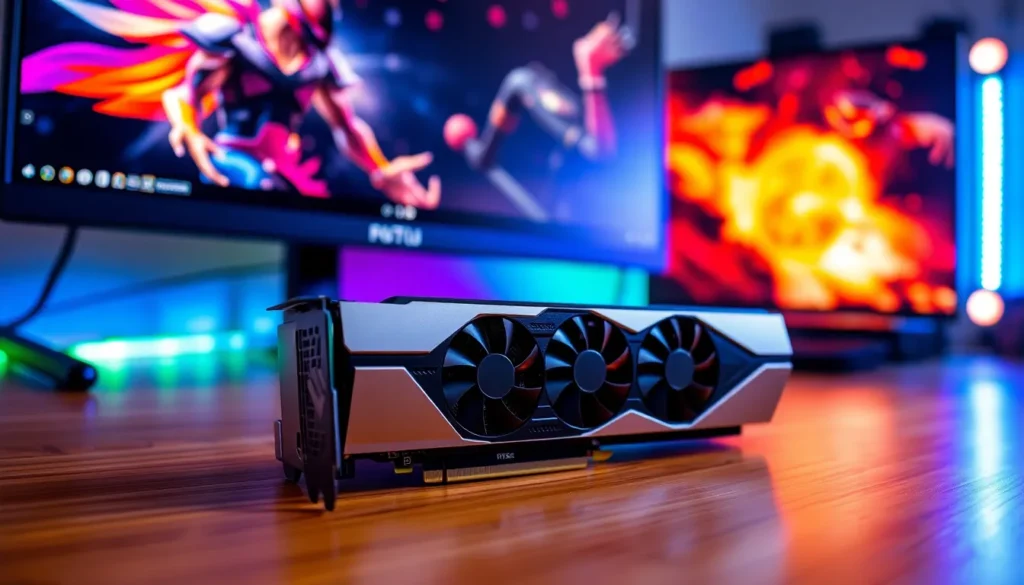In the ever-evolving world of gaming, the quest for the perfect graphics card can feel like searching for a needle in a haystack—especially when that needle costs an arm and a leg. Enter the RTX 3050, a card that promises to deliver solid performance without breaking the bank. But is it truly the gaming powerhouse it claims to be, or just another overhyped gadget?
With its sleek design and enticing price tag, the RTX 3050 has gamers buzzing. It’s like that friend who shows up to the party with snacks—everyone’s happy to see it, but does it really bring the fun? Let’s dive into the nitty-gritty and find out if this GPU is the right fit for those epic gaming sessions or just a flashy distraction in a crowded market.
Is RTX 3050 Good for Gaming
RTX 3050 offers a solid entry point for gamers seeking performance without spending excessively. It’s built on NVIDIA’s Ampere architecture, supporting features like real-time ray tracing and DLSS (Deep Learning Super Sampling). With a TDP of 130W, it provides a balance between efficiency and power.
Memory specifications include 8GB of GDDR6, allowing for decent performance in modern titles. This card competes well in 1080p gaming, often delivering frame rates above 60 FPS in popular games. Additionally, it handles competitive esports titles effectively, ensuring smooth gameplay during intense matches.
In terms of connectivity, RTX 3050 includes HDMI 2.1 and DisplayPort 1.4a, accommodating high refresh rates and resolutions. These features make it versatile, catering to various gaming setups. This card’s pricing, while competitive, often fluctuates due to market demand, typically ranging from $250 to $350.
For gamers on a budget, considering system requirements becomes crucial. RTX 3050 pairs well with mid-range processors like AMD Ryzen 5 and Intel Core i5. This combination ensures that bottlenecking remains minimal, maximizing performance potential.
Benchmarking results indicate the card excels in recent titles, achieving playable frame rates on medium to high settings. Games such as Cyberpunk 2077 and Call of Duty: Warzone demonstrate its capability, making it an attractive option for casual and dedicated gamers alike.
Gamers evaluating options will find that RTX 3050 creates a strong case for value in the current graphics card landscape.
Performance Analysis

The RTX 3050 graphics card offers commendable performance for gamers, particularly at its price point. It stands out in benchmarks across various games, making it a suitable option for many.
Gaming Benchmarks
Benchmark tests demonstrate the RTX 3050’s ability to handle modern titles effectively. In popular games like Cyberpunk 2077, it averages around 45 to 60 FPS on high settings. Call of Duty: Warzone also sees performance figures in the same range. These metrics indicate that the card can compete robustly in the gaming landscape, catering to casual and competitive players alike. Additionally, benchmarking shows that it maintains better performance at 1080p compared to older GPU models, reinforcing its appeal for budget-focused gamers.
Resolution and Settings
In terms of resolution, the RTX 3050 excels at 1080p gaming, delivering consistent frame rates that enhance gameplay. Opting for medium to high settings typically results in a smooth gaming experience across various genres. Players can even experiment with ray tracing settings in some titles, although performance may dip slightly. The card’s 8GB of GDDR6 memory enables it to handle textures well at this resolution. For gamers seeking excellent visuals without sacrificing performance, the RTX 3050 strikes a balance that appeals to a wide range of gaming preferences.
Comparison with Other GPUs
The RTX 3050 fits neatly into a competitive landscape filled with powerful graphics cards.
RTX 3060 vs RTX 3050
The RTX 3060 significantly outperforms the RTX 3050, offering enhanced capabilities that make it a better option for gamers seeking higher standards. Featuring 12GB of GDDR6 memory, the RTX 3060 handles more demanding titles with ease. Frame rate averages hover around 60 to 80 FPS in modern games at 1080p with higher settings, ensuring smoother gameplay. Ray tracing performance also shines with the RTX 3060, providing a noticeable upgrade in visual fidelity compared to the RTX 3050. Thus, for gamers looking to future-proof their systems, the RTX 3060 emerges as a more viable investment, despite a higher price point typically ranging from $350 to $450.
AMD Alternatives
AMD presents notable alternatives in its Radeon RX 6000 series, specifically the RX 6600 and RX 6600 XT. These GPUs compete directly with the RTX 3050, often delivering comparable frame rates in many titles. Performance-wise, the RX 6600 generally averages around 50 to 70 FPS at 1080p, making it a solid contender. The RX 6600 XT surpasses this, regularly hitting 60 to 90 FPS, thus capturing attention from gamers. Both cards offer excellent performance without ray tracing but shine in rasterization capabilities. Pricing for these AMD options varies from $250 to $350, making them attractive for budget-conscious gamers seeking performance in popular titles.
Price to Performance Ratio
The RTX 3050 offers a competitive price-to-performance ratio, appealing to budget-conscious gamers. At a price range of $250 to $350, it provides decent capabilities, particularly in 1080p gaming scenarios. Gamers can achieve frame rates above 60 FPS in many titles, which enhances gameplay without breaking the bank.
Performance metrics show the RTX 3050 averaging around 45 to 60 FPS on high settings in games like Cyberpunk 2077 and Call of Duty: Warzone. Comparatively, its similar competitors, such as the RX 6600, achieve frame rates between 50 to 70 FPS, positioning them as strong alternatives.
The card excels in handling modern titles, making it a solid entry-level choice. Benchmarks display its efficiency, particularly in esports titles, where smooth gameplay remains crucial. Efficiency becomes even more significant for gamers pairing this GPU with mid-range processors like AMD Ryzen 5 or Intel Core i5, minimizing bottlenecking while maximizing performance.
Notably, the RTX 3060 outshines the RTX 3050 in terms of performance, with 12GB of GDDR6 memory and frame rates averaging 60 to 80 FPS at 1080p. While it demands a higher price of $350 to $450, investors in gaming rigs often find the additional cost justifiable for enhanced performance.
Gamers evaluating the RTX 3050 should consider their budget and gaming preferences. The card strikes an admirable balance of performance and cost, solidifying its place in the current graphics card market.
Conclusion
The RTX 3050 stands out as a compelling choice for gamers on a budget. Its performance in 1080p gaming and support for modern features like ray tracing make it a valuable addition to many gaming setups. While it may not match the capabilities of higher-end models like the RTX 3060, it offers solid performance for its price range.
For casual gamers and those focused on esports, the RTX 3050 delivers a satisfying experience without breaking the bank. Ultimately, it balances affordability and performance, making it a worthy investment for those looking to enhance their gaming experience without overspending.

